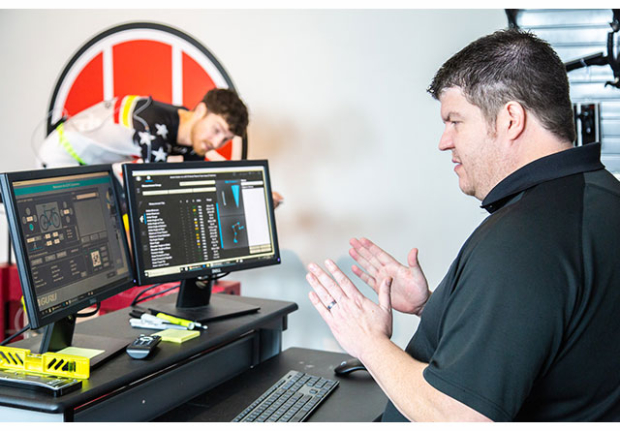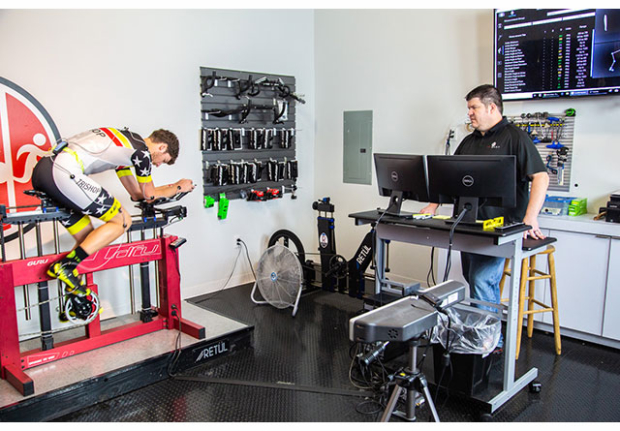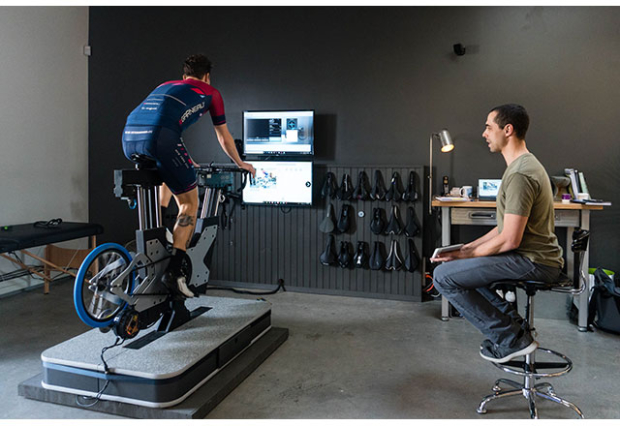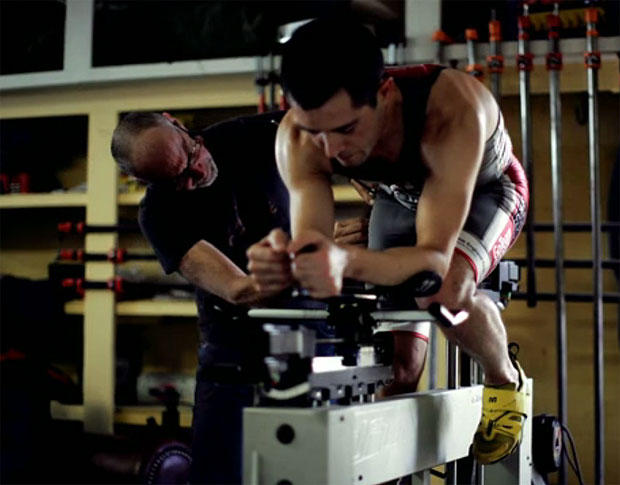Trent Nix: A Bike Fit Oasis in the Southern Plains
The point of this series – I'm profiling a bike fitter every week – is not to claim this is the exhaustive list, just to say, let's uncover the fitters I'd trust sending my grandmother to (if she was still alive and doing triathlons).
I can’t say whether or not Trent Nix and Trishop Plano is the only place to get a first class fit in metro Dallas. Is it a place I can unreservedly recommend? Let's investigate…
Equipment and Tooling: As you may know by now, there are 2 methods for fitting someone to his or her bike: static and dynamic. A static bike fit system relies solely or mainly on “body segments”, such as inseam and arm length. A dynamic system fits you as you pedal your bike. So, if you use (for example) a “motion capture” system, like Retül, that word “motion” is evocative. What always humors and pains me is to see a fitter with a $13,000 Retül system executing his fit aboard the customer’s own bike on a trainer.

Time is money. You can’t easily make changes to a position to conform to a motion capture system’s angular range unless those positional changes can be done quickly. Which means a conforming fit bike! Trent has two: a GURU Gen 1 and a Retül Müve. Trent will use the GURU most of the time. Why? Not because it’s a fancy shmancy motorized fit bike, but because it instantaneously reads the metrics, as he’s fitting. Data is also money.
According to Trent, “Whether you’re buying an $800 road bike or $8000 tri bike, the first step towards purchase is a session on the fit bike.” This makes perfect sense to Trent, and to me, because: to other shops, who don’t implicitly know the math, a fit bike slows the process. To one who understands the math, a fit bike speeds up the process.
Trent’s got a Retül motion capture, and to archive bike and body landmarks he uses a Retül Zin – a habit he religiously follows. Trishop has the standard cleat stuff – Speedplay kit, wedges, etc.
Not all the tools need be hi-tech. “One of the best fit tools I have in my toolbox is my iPhone and the slo-mo camera. It makes the Retül measurements mostly a rubber stamp and is an excellent way to train your eye as a fitter.”
Trent built his own app called Fit Finder to take fit coordinates and compare against a database of bikes that his team has curated. He uses it for every new bike fit. This provides a report that, in addition to the Retül report, provides the customer with a data overload when it comes to buying the right bike. Which leads us to deliverables.

Deliverables: If you’re sprucing up your existing bike, you walk away with a fit report that includes some remarks from a short physiological assessment, their specific bike measurements, body geometry data from both sides, and before and after photos from the fit. The Retül software does most of the heavy lifting with this report. For fitters that use Retül, there’s really zero excuse not to provide this report. For new bikes, a customer receives the same fit report along with Trishop’s Fit Finder report which contains bike recommendations that accommodate their fit coordinates (and additionally filtered using fitter discretion, budget, aesthetic or brand preferences, etc.). If a customer is interested in bikes they don’t carry or haven’t measured, they walk the customer through those recommendations based on the data manufacturers have published online. You’ll get a video of your position upon request (bring a thumb drive).
Background and Bona Fides: Trent was a computer and software scientists in his former life, as you might have guessed. He’s been to every F.I.S.T. course I offer and is a Retül Level I and Advanced graduate.
Portfolio: Not every fitter has a portfolio of fits, even those who I’m profiling in this series. But Trent does have one. To me, this is the truth-teller. Show me your work product. Then I don’t even need to ask your fit philosophy – I’ll see it.
What Drives the Fit Decisions: I ask this of every fitter I profile. This is a technical question. Literally, what input causes you to make a fit coordinate decision (what, precisely, causes you to, for example, lengthen a rider’s cockpit?). Here’s what Trent said:
“At a macro level, orthodoxy drives the decisions we make. A fit simply has to end up in an orthodox position or it’s wrong. We use some of the Retül ranges – especially knee extension and hip angle – to define orthodoxy. And in a couple of other cases we slightly stray outside of the Retül range – namely hip-should-elbow (we stretch people out just a bit further than the Retül range recommends).
“At a micro level, we consider rider feedback, budget, and equipment. For example, if a customer is hoping to buy a Scott Plasma 5, they won’t have the ability to angle the armpads because of the way the front-end on the Plasma 5 works. So we have to consider that limitation up front on the fit bike. Budget is really an important consideration that is almost never discussed. It’s easy to throw around solutions like shorter cranks and different bars and extensions and so on, but in a retail environment most of our fits don’t have the budget to consider those solutions. So we have to work around the customer’s equipment (if we are fitting them on their bike) and their budget.”
Price: $199 for a Pro Fit (on your bike). $199 for a session on the fit bike that is credited back to the customer if they purchase from the shop.
Above is a video that Trishop has prepared (one of a bunch it’s made you’ll find on its Youtube channel). It’s about 2 minutes long and I think if you watch this video you’ll get a sense for why I consider these folks the cream of the metro-Dallas area, and well worth the drive if you're not in Metro-Dallas:
My FuBAR Question: Which stands for Fitters BAR exam question. This is the gotcha question I ask every fitter in this series, with the warning: “I’m going to ask a question, you don’t know what it is, it’s going to be technical, and I’m going to print the answer. Are you sure you want me to profile you?” Here’s my question to Trent:
QUESTION: “My Hy/Hx for my gravel bike is 630mm/495mm respectively, if used with a bar with a 70mm reach. Is there a gravel bike out there for me? What would a complete bike solution look like for me?” Here is his answer:
“With a 630/495 HY/HX, a few stem options and a little trig will help us back into frame geometries that would be appropriate. [And then he produced for me the table below]:

“Stock bikes are going to have a stem pitch in the -6 to -8 range, and a few bikes will have a 20 mm top cap and others will have a 10 mm top cap, depending on the manufacturer. So I’m going to look for bikes with a stack a little lower than was as prescribed (so 560-580), and a reach of 385 to 395 or so. Our Fit Finder tool actually does the trig for us and lets us set our own pitch, stem length, and topcap sizes. Of the bikes we carry, the following are within that range:
• Allied Alfa All-Road (56) (full Ultegra build around $5000) –
Stack: 562, Reach: 394 – 110 stem at -6 with 10 mm top cap and 20 mm of spacers
• 3T Exploro (Large) (Team Rival build under $6000) –
Stack: 575, Reach: 390 – 110 stem at -6 with 10 mm top cap and 5 mm of spacers
• Scott Speedster Gravel (54) (alloy frame with 105 at $1600, Tiagra option at $1200) –
Stack: 571, Reach: 381 – 120 stem at -6 with 10 mm top cap and 10 mm of spacers
• Scott Addict Gravel (56) (105 option starts at $3300, Ultegra option at $3700, SRAM Force 1x option at $6199) –
Stack: 583, Reach: 390 – 110 stem at -6 with 10 mm top cap and no additional spacers.
“You’ve got lots of options.”
That was Trent’s answer. You don't follow his math or his reasoning? You're not expected to. He got it all right, to within a couple of millimeters, the precision this industry allows.
There are 3 ways I know if a fitter is fully equipped to transact business: 1) Does he or she have the proper tooling in his studio; 2) In the methodology, does the fitter attempt to drive his customers toward orthodox positions? (I hope so!); and, 3) The answers to my FuBAR questions tell me, very quickly, whether fitters are ready to take your money. My mission for the past 15 or so years, designing fit bikes, naming and establishing Stack and Reach as frame metrics, designing dynamic fit protocols, is to equip fitters to answer very hard, very technical questions like this. To create a pathway by which fitters can answer the question, “What bike mathematically is demonstrated to best sit underneath my optimized position?”
See how Trent answered this question? It’s pretty much how Jon Blyer (ACME Bicycle Co., Brooklyn, NY) answered a similar question in the first installment in this series. That’s how you know a bike fitter deserves to take your money. Read more about Trishop in Plano, Texas. Look for more fitter profiles each week.





Start the discussion at slowtwitch.northend.network